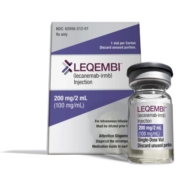Senolytic Therapies pose revolutionary potential to roll back diseases of aging
Senolytic Therapies pose revolutionary potential to roll back diseases of aging
Published: Dec 15, 2022
By Gail Dutton
BioSpace
Senolytic therapies are, at this point, as revolutionary as checkpoint inhibitors but with broader effectiveness. This approach delays the onset of diseases of aging by removing senescent cells from the body, thus enabling people to remain healthier longer or to regain some degree of function lost to disease.
Senolytics is a new field and most of the research is still in academic centers – most notably, the Mayo Clinic. Approval of any therapeutics is years – perhaps even a decade – away.
Currently, there are many unknowns. Laura Niedernhofer, M.D., Ph.D., a senolytics pioneer and professor in the department of biochemistry, molecular biology and biophysics at the University of Minnesota, highlighted just a couple in an interview with BioSpace.
“We’re at the stage where we don’t know – in humans – which cells senesce and when, so there would be concern if, for example, post-mitotic cells that can’t be replaced were suddenly eliminated by senolytics,” she said. “We also don’t know which senescent cells are the most disadvantageous.”
On the flip side, “Senescent cells also have healthy properties. They play an important role in wound healing and other physiologic processes,” Niedernhofer said. “In a perfect world, you would be able to target senolytics to very specific lineages of senescent cells, but we know how hard that is to do in cancer, so I think it’s asking for a lot.”
Translational Challenges
Neuroscientist Anirvan Ghosh, Ph.D., CEO of Unity Biotechnology, first encountered senescent cells in the context of Alzheimer’s disease.
“What caught my attention was evidence showing the accumulation of senescent cells in the aging brain,” he told BioSpace. “Non-neuronal cells in the brain provide various kinds of support functions, including helping synaptic functions, and they end up in a senescent state. I thought a dysfunction in some other population of cells may be driving some part of the disease.”
Ghosh found the consistency of evidence across animals and systems compelling. “The fundamental observation was that in the context of aging in vertebrates, there is a big increase in the number of the cells that are non-dividing, metabolically active cells.”
“We’re all carrying some burden of senescent cells…usually at a benign level, and it’s very likely contributing to the aging process. But, in certain stressed environments, the risk burden increases,” he noted. A normal aging eye, for example, shows some accumulation of senescent cells but, when a disease – macular degeneration or diabetes, for example – is also involved, senescent cells are even more abundant.
Senescent cells express the protein p16. Ghosh said it is possible to engineer mice “so you can use a promoter to, essentially, tag the p16-positive cells and then inject a drug that will target those cells. In humans, you have to find a protein or target in the senescent cells that will kill those cells but not the neighboring, healthy cells.”
Unity’s approach identifies these cells based on their state – specifically their expression of p16 and their secretion of inflammatory factors. The company’s lead asset, UBX1325, targets BCL-xl, which senescent cells – but not healthy cells – require for survival. “If you starve them of that, they are eliminated,” Ghosh explained.
UBX1325 is being developed to treat diabetic macular edema (DME) and age-related macular degeneration.
Upwards of 100 patients have been treated in early trials.
UBX1325 pathology is injected into the eye, “so the entire eye is being bathed with this drug,” Ghosh said. As a result…disease is reduced, the anatomy looks good and the patients see better. The average gain was 7.5 letters or two lines on a vision chart. That gain was also seen in patients who had plateaued on anti-VEGF therapy and were treated with senolytics.
A single injection appears to confer durable benefit.
“We have patients who have been out to six months after a single injection and a very significant majority of them do not need a second injection. All gained vision well above where they started,” Ghosh said. The expectation is that senolytics may be able to bring the eye, in this case, to a younger state, prolonging its health span.
Senescent Cells Drive Disease Progression
Bringing senolytic therapies to market will be aided by a growing acknowledgment of the root causes of aging.
“Nephrologists have begun to realize that acute accumulation of senescent cells drives progression of disease and the pathologies associated with it and that this accumulation of inflammatory cells leads to more fibrosis and more inflammation,” Matthew Scholz, founder and CEO of Oisín Biotechnologies told BioSpace.
“Senolytics is exciting because it’s the first of a class of therapy that has the potential to go after aging more broadly,” Scholz said. “Senescence seems to affect everyone and all the major organ systems in the body. One of the first things shown in transgenic animals was that if you remove (these cells) there was meaningful improvement in lifespan and healthspan. If we don’t recognize aging as a legitimate target for medical intervention, it will be difficult to move the needle,” beyond cosmetic treatments or lifestyle interventions.
Beta-galactosidase, an enzyme in the lysosomes, was one of the early biomarkers for senescent cells. Images on Oisín’s website show no senescence in the kidney cells of 4-month-old mice, a considerable amount in the kidney tissue of 80-week-old mice and significantly less post-treatment.
Studies show that mice treated with senolytics lived longer and had better health but, Scholz stressed, still eventually died. In mice, “Senolytics increased life span from birth by about 20%,” he recalled, “and if you’re counting (life extension) from old age, the improvement is massive. We’d lost half our control mice to old age before a single treated mouse died, so it’s really significant.”
Oisín’s furthest-advanced senolytics program addresses kidney disease.
“One application focuses on blocking the progression of acute kidney injury toward chronic kidney disease,” Scholz said. The other application is for people with advanced kidney disease who may be approaching renal failure. Eliminating the senescent cells probably won’t return those kidneys to full function, but it may retard or halt disease progression.
The goal is to eliminate the p16 cells. The company does that by targeting p16+cells with a caspase-9 suicide gene. The senescent cells then die by apoptosis.
Although the p16 pathway is critical in identifying senescent cells, it may not be the only possible pathway. As Scholz said, “the body has remarkable levels of redundancy. For most systems, there’s more than one pathway.”
Recognizing that, the company’s new frailty study targets both the p16 and p53 pathways, creating a synergistic, two-pronged method of killing senescent cells. That approach may be applied to its kidney program in the future.
The question of unintended consequences is ever-present when pioneering new fields.
Oisín attempted to address that in a blinded comparison study of non-human primates who received either placebo or the therapy. There were no discernable differences, according to the pathologist, Scholz said. “It’s an admittedly low-tech method, but the treatment didn’t appear to cause any harm.”
Senolytics is a completely new type of therapy that, at this admittedly early stage, appears to have great promise. If it delivers on that promise, it will change what it means to age irrevocably.
Source: BioSpace










